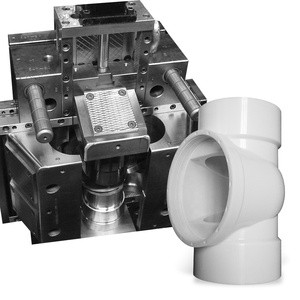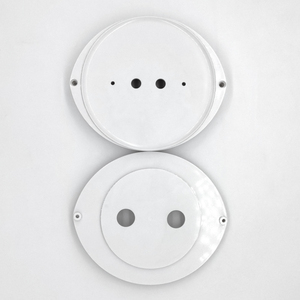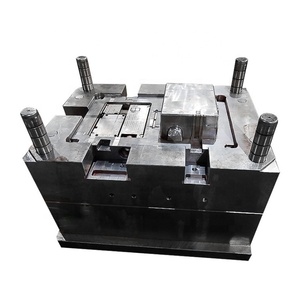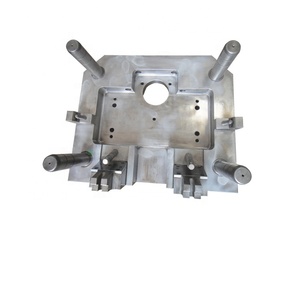
All categories
Featured selections
Trade Assurance
Buyer Central
Help Center
Get the app
Become a supplier

(495 products available)




















Mechanical Engineering offers several processing methods. These methods allow manufacturers to produce plastic components of different sizes and shapes. Therefore, each type is suitable for specific applications, depending on the materials being utilised.
These used injection moulding die types are discussed in detail as follows:
Cold runner moulds have solidified plastic waste. The solidified plastic wastes are located within the runner system. Therefore, it is economical to use. However, it is less efficient compared to other types. Thus, these moulds are often used for smaller parts or lower production volumes.
Hot runner moulds keep the plastic in a molten state. It keeps the plastic in a molten state to reduce waste. This reduction also minimises the cost of operation. This highly efficient system also get rid of residuals. Therefore, this type is highly suitable for high-volume production. This makes it popular in industries like automotive.
Multi-cavity moulds have more than one cavity. The more the cavities, the more parts produced in a single cycle. Therefore, it increases production rate significantly. These injection moulding dies are also ideal for large-scale production. This is because they help maintain parts consistency.
These moulds consist of multiple layers of cavities. Each layer produces one part. Thus, these moulds combine the benefits of multi-cavity and traditional moulds. They do this by enhancing production capacity. Therefore, they are suitable for businesses requiring a quick turnaround time.
As the name suggests, insert moulds incorporate metal or other materials as inserts. They include materials like metal or other materials in inserts. It allows for parts that require reinforcements or combined materials. These moulds find common use in electronics. They also find common use in automotive components.
A used injection mold requires regular maintenance and periodic checks for wear. Moreover, a company’s decision to invest in a used injection moulding die will depend on the type of components it will produce. This is due to the various die types used to make these components.
Some of these die types include:
High-speed steel (HSS) is a popular material. This is because of its durability and ability to withstand high temperatures. Its capacity to retain sharp edges makes it suitable for complex moulds. This allows detailed designs.
Also known as cemented carbide, tungsten carbide is one of the toughest materials available in the market. The toughness enables it to resist wear and tear effectively. Therefore, it is suitable for high-volume productions. It is also ideal for industries that deal with abrasive materials.
Aluminium is a lightweight option. Its lightweight nature makes it easy to machine. It makes it a practical choice for prototyping and short production runs. This material has excellent thermal conductivity. The conductivity ensures even heat distribution. Therefore, it reduces cycle times significantly.
Steel alloys combine different metals. These metals include nickel and chromium. These metals increase their resistance to corrosion and wear. Company owners can customise these alloys. This customisation allows them to meet specific production requirements. Steel is often preferred for making plastic injection moulding kits used in large-scale operations.
Bronze alloys are ideal for inserts and cores. They are ideal because they offer a balance between hardness and machinability. It is also suitable for high-precision moulds. Their resistance to corrosion makes them ideal for harsh environments.
Manufacturers in various industries utilise plastic injection molding shadows to produce parts in large quantities. This is due to its efficiency, precision, and cost-effectiveness. Therefore, understanding which scenario is best for this product will help improve operations.
The scenarios where used injection moulding die shine the most are:
In the automotive industry, manufacturers use these dies to produce components like dashboards and bumpers. It also helps produce complex parts with tight tolerances. Thus, ensuring consistent quality. The automotive industry benefits from the efficiency and strength of the materials used.
Manufacturers here produce housings, buttons, and other casings. They produce these components using the dies in the electronics space. Thus ensuring rapid production without sacrificing accuracy. They achieve the accuracy by using plastic injection molding to produce intricate designs required in gadgets.
The medical sector demands stringent hygiene standards. Injection moulding dies help meet these standards. They do this by producing disposables like syringes. People in this industry prioritise biocompatible plastics. These plastics come in handy when making medical components in this space.
This industry requires plastic injection moulding dies to produce bottles, containers, and casings. These containers help protect and preserve products. Operating these dies is affordable and easy for companies with a high demand for packaging solutions.
Here, manufacturers carry out the production of gears, housings, and other mechanical components. They perform the production using these moulding dies. They do this because the dies manufacture durable parts that quickly and easily handle heavy workloads. Moreover, they maintain high precision even when under pressure.
When buying injection molding machines for sale, customers should consider the dies’ specifications and maintenance. It ensures that the dies lodge and function correctly. It also ensures that the dies operate efficiently for long periods.
Some of the key factors to consider are:
Moulds with a responsive thermal regulation system ensure the resin maintains optimal temperatures during injection. Therefore, it reduces cycle times. It also minimises energy consumption. This feature is crucial for producing parts with tight tolerances.
Cavities significantly affect the quality and complexity of the produced parts. The die's designers make multi-cavity or segmented block options. These options allow flexibility in the production of components. They also help in complex moulds. Complex moulds are often required by the automotive and electronics industries.
Easy-access bolts and wear parts help simplify maintenance tasks. The simplified maintenance task allows quick changeovers. It also minimises downtime. Moreover, corrosion-resistant coatings will reduce wear over time. It will ultimately lower long-term maintenance costs.
How and where customers mount or use their injection moulding kits will affect the types of components they produce. It will also affect the die they choose to invest in.
Some common ways customers use these moulds include:
Those in high-production industries like automotive will benefit from multi-cavity moulds. Multi-cavity moulds are ideal for large-scale production. They offer the necessary speed without compromising on quality. On the other hand, low-volume industries can settle for single-cavity moulds. It is because they still produce components with high precision.
Manufacturers make used injection molding dies to provide compatibility with various plastics. These plastics include ABS, polycarbonate, and polypropylene. Each material has unique requirements. They ensure a precise moulding process by carefully selecting dies that match these requirements. Therefore, this ensures that customers achieve optimal results.
Injection molds in consumer electronics require precision and consistency. Injection molds in this space often use hot runner moulds. Hot runner moulds eliminate waste and enhance the surface finish of electronic components. This refinement is crucial in producing complex casings and intricate parts.
To keep the dies in good condition and continue offering quality products, buyers must maintain these dies. Here are some measures to take:
They should do thorough cleaning after each production run. This is to prevent residue build-up. Residue build-up causes defects over time. They can use solvent-based cleaners or ultrasonic cleaning devices. These devices will ensure nothing short of ideal cleanliness is achieved.
Users should inspect mould components regularly. It will help them identify signs of wear. The earlier they identify the signs of wear, the faster they can replace worn parts like ejector pins and bushings. They can perform this inspection during scheduled maintenance or after a high-volume production run.
Users should lubricate moving parts like ejectors and slides. It will reduce friction and allow easy operation. It also reduces the risk of component seizures, which can harm the machinery. Use high-quality mould lubricants. Apply them sparingly so as not to contaminate the mould cavity.
Users should ensure that the mould maintains the right temperature. It is essential for effective plastic injection molding. Thermoregulation devices will help in this process. They will also ensure that temperature variations do not affect the resin consistency. Therefore, users should check for leaks in heating or cooling channels. Leaks cause inconsistent product results.
A1. Cold runner moulds have solidified plastic waste. This solidified plastic waste is located within the runner system. Therefore, it is economical to use. However, it is less efficient compared to other types. On the other hand, hot runner moulds keep the plastic in a molten state. It reduces waste and minimises the cost of operation. This highly efficient system removes residuals. Therefore, this option is highly suitable for high-volume production. It makes it a popular choice in the automotive industry.
A2. The automotive industry, consumer electronics, medical devices, packaging, and industrial equipment sectors depend on these injection moulding dies. These industries are in high demand for producing complex components quickly and efficiently. They also require this product to ensure precision, cost-effectiveness, and scalability.
A3. The most common maintenance practice buyers have to perform is a regular cleaning session. It helps remove residues. Residues left on the moulds can cause defects over time. Therefore, it is vital to maintain an ideal cleanliness level.
A4. The operational efficiency of these moulding die manufacturers depends on the moulds’ thermal regulation systems. These systems allow quick heat adjustments, minimise energy consumption, and ensure optimal resin temperatures.
A5. The first sign is difficulty in operating certain machines. Other signs include minor damage or indents on the machines and machines producing low-quality products.